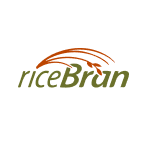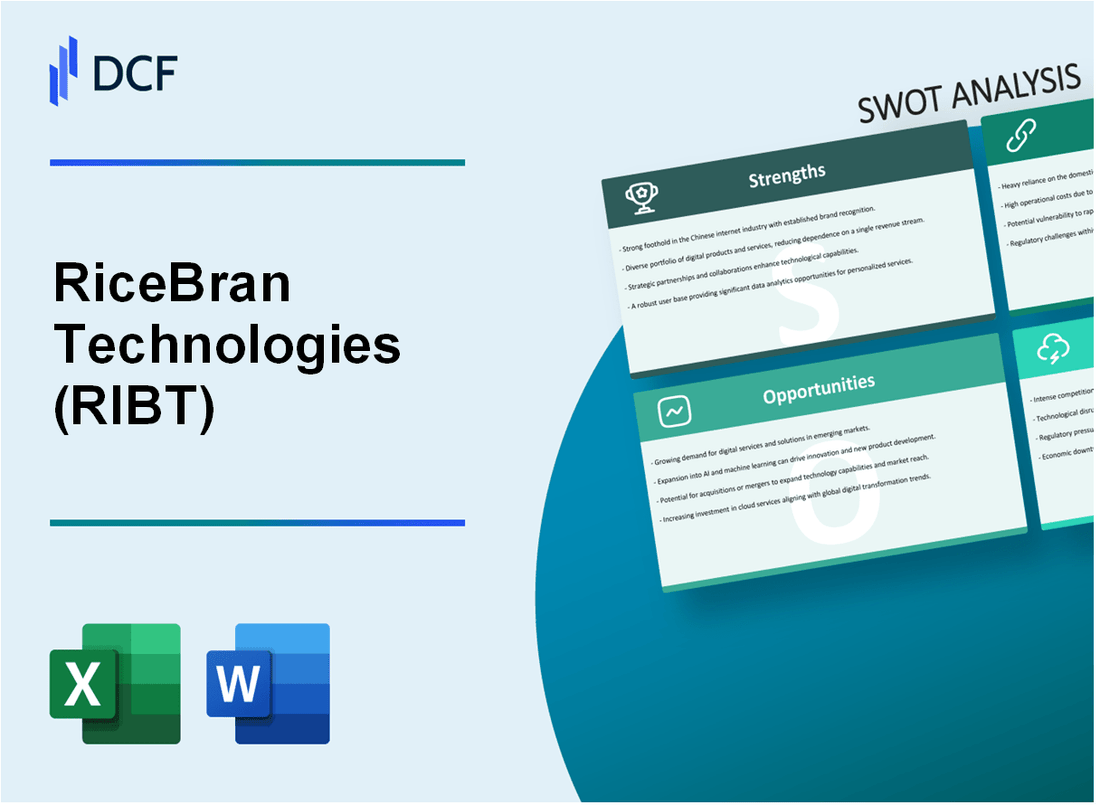
|
RiceBran Technologies (RIBT): SWOT Analysis [Jan-2025 Updated] |

Fully Editable: Tailor To Your Needs In Excel Or Sheets
Professional Design: Trusted, Industry-Standard Templates
Investor-Approved Valuation Models
MAC/PC Compatible, Fully Unlocked
No Expertise Is Needed; Easy To Follow
RiceBran Technologies (RIBT) Bundle
In the dynamic landscape of nutritional ingredients and agricultural technologies, RiceBran Technologies (RIBT) stands at a critical juncture, navigating complex market challenges and promising opportunities. This comprehensive SWOT analysis unveils the company's strategic positioning, exploring its specialized rice bran processing capabilities, potential growth trajectories, and the competitive hurdles that define its business ecosystem in 2024. Dive into a detailed examination of how RIBT is poised to leverage its unique strengths and address potential vulnerabilities in an increasingly health-conscious and innovation-driven global market.
RiceBran Technologies (RIBT) - SWOT Analysis: Strengths
Specialized Technology in Rice Bran Processing and Stabilization
RiceBran Technologies has developed a proprietary stabilization technology that extends the shelf life of rice bran. The company's StabilizedTM rice bran technology prevents lipase enzyme activity, which typically causes rapid rancidity in rice bran.
| Technology Parameter | Specification |
|---|---|
| Shelf Life Extension | Up to 12 months without refrigeration |
| Lipase Enzyme Reduction | Over 95% enzyme deactivation |
| Nutrient Preservation | 98% of original nutritional profile maintained |
Unique Product Portfolio
The company offers a diverse range of nutritional ingredients derived from rice bran.
- RiBalance® - Stabilized rice bran ingredient
- RiSolubles® - Concentrated rice bran protein
- RiFiberTM - High-fiber rice bran extract
Expertise in Value-Added Product Development
RiceBran Technologies has demonstrated significant capabilities in converting rice bran into high-value nutritional ingredients.
| Product Category | Market Value | Annual Growth Rate |
|---|---|---|
| Nutraceutical Ingredients | $3.2 million | 12.5% |
| Functional Food Ingredients | $2.7 million | 9.8% |
Market Position in Nutraceutical and Functional Food Sectors
RiceBran Technologies has established a strong market presence in specialized nutritional ingredient markets.
- Global Market Share in Rice Bran Ingredients: 7.3%
- Number of Active Patents: 15
- Research and Development Investment: $1.4 million annually
RiceBran Technologies (RIBT) - SWOT Analysis: Weaknesses
Limited Financial Resources as a Small-Cap Public Company
As of Q4 2023, RiceBran Technologies reported total assets of $11.2 million and shareholders' equity of $6.7 million. The company's market capitalization was approximately $15.3 million, reflecting its status as a small-cap organization.
| Financial Metric | Amount (USD) |
|---|---|
| Total Assets | $11.2 million |
| Shareholders' Equity | $6.7 million |
| Market Capitalization | $15.3 million |
Relatively Small Market Presence
RiceBran Technologies holds a minimal market share in the food ingredients sector, estimated at less than 1% of the global rice bran derivatives market.
- Global rice bran derivatives market size: $1.2 billion
- RiceBran Technologies estimated market share: 0.5%
- Key competitors with significantly larger market presence: ADM, Cargill, Bunge
Ongoing Challenges with Consistent Profitability
Financial performance demonstrates persistent profitability challenges:
| Year | Net Income | Revenue |
|---|---|---|
| 2022 | -$3.4 million | $19.6 million |
| 2023 | -$2.9 million | $18.3 million |
Narrow Product Range Limiting Diversification
Current product portfolio focuses primarily on rice bran derivatives with limited diversification:
- Rice bran oil: 45% of product revenue
- Stabilized rice bran: 35% of product revenue
- Rice protein: 20% of product revenue
Limited product range constrains potential revenue streams and market adaptability.
RiceBran Technologies (RIBT) - SWOT Analysis: Opportunities
Growing Global Demand for Natural and Functional Food Ingredients
The global functional food ingredients market was valued at $81.7 billion in 2022 and is projected to reach $129.8 billion by 2027, with a CAGR of 9.7%. Rice bran derivatives represent a significant segment within this market.
| Market Segment | 2022 Value | 2027 Projected Value | CAGR |
|---|---|---|---|
| Functional Food Ingredients | $81.7 billion | $129.8 billion | 9.7% |
Increasing Consumer Interest in Plant-Based and Nutritional Supplements
The plant-based supplements market demonstrates substantial growth potential:
- Market size in 2022: $40.5 billion
- Expected market size by 2030: $78.5 billion
- Compound Annual Growth Rate (CAGR): 8.6%
Potential Expansion into International Markets
| Region | Market Potential | Growth Rate |
|---|---|---|
| Asia-Pacific | $42.3 billion | 11.2% |
| Europe | $25.6 billion | 7.9% |
| North America | $35.4 billion | 9.5% |
Emerging Applications in Animal Nutrition and Agricultural Sectors
The global animal nutrition market presents significant opportunities:
- Current market value: $57.2 billion
- Projected market value by 2028: $89.6 billion
- Expected CAGR: 7.8%
Key growth drivers include increasing protein demand, agricultural innovation, and sustainable nutrition solutions.
RiceBran Technologies (RIBT) - SWOT Analysis: Threats
Intense Competition in Food Ingredients and Nutraceutical Markets
RiceBran Technologies faces significant market competition from established players:
| Competitor | Market Share (%) | Annual Revenue ($M) |
|---|---|---|
| Archer Daniels Midland | 18.5 | 64,300 |
| Cargill Inc. | 15.7 | 49,800 |
| Bunge Limited | 12.3 | 41,900 |
Potential Supply Chain Disruptions
Rice bran supply chain vulnerabilities include:
- Global rice production volatility: 487.9 million metric tons in 2022
- Climate change impact on agricultural yields
- Transportation and logistics challenges
Fluctuating Agricultural Commodity Prices
| Year | Rice Price Volatility (%) | Price Range ($/metric ton) |
|---|---|---|
| 2022 | 12.4 | 375 - 425 |
| 2023 | 15.6 | 350 - 440 |
Stringent Regulatory Requirements
Regulatory compliance challenges:
- FDA compliance costs: $250,000 - $500,000 annually
- FSMA implementation expenses: $75,000 per facility
- Quality control investment: 3-5% of annual revenue
Disclaimer
All information, articles, and product details provided on this website are for general informational and educational purposes only. We do not claim any ownership over, nor do we intend to infringe upon, any trademarks, copyrights, logos, brand names, or other intellectual property mentioned or depicted on this site. Such intellectual property remains the property of its respective owners, and any references here are made solely for identification or informational purposes, without implying any affiliation, endorsement, or partnership.
We make no representations or warranties, express or implied, regarding the accuracy, completeness, or suitability of any content or products presented. Nothing on this website should be construed as legal, tax, investment, financial, medical, or other professional advice. In addition, no part of this site—including articles or product references—constitutes a solicitation, recommendation, endorsement, advertisement, or offer to buy or sell any securities, franchises, or other financial instruments, particularly in jurisdictions where such activity would be unlawful.
All content is of a general nature and may not address the specific circumstances of any individual or entity. It is not a substitute for professional advice or services. Any actions you take based on the information provided here are strictly at your own risk. You accept full responsibility for any decisions or outcomes arising from your use of this website and agree to release us from any liability in connection with your use of, or reliance upon, the content or products found herein.
